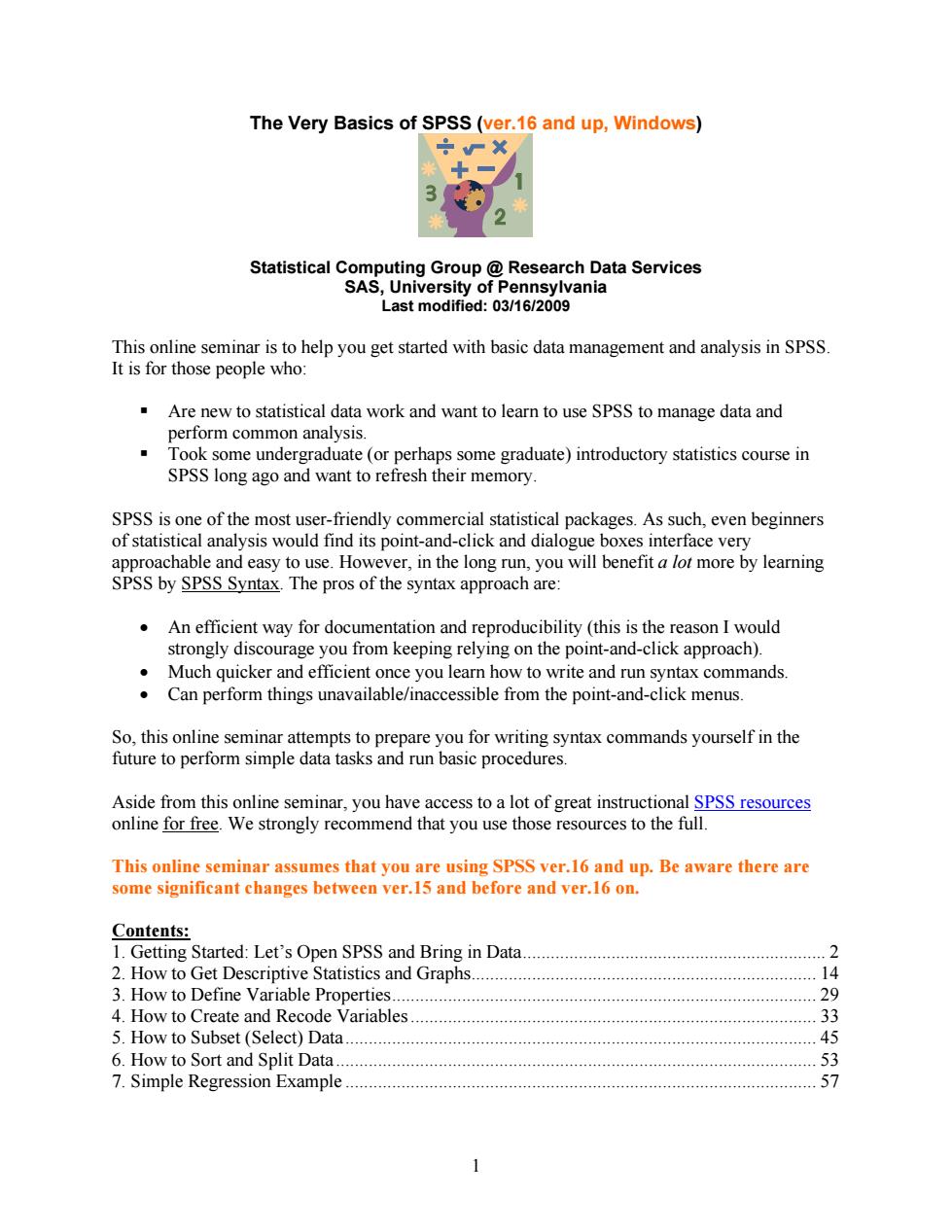正在加载图片...

The Very Basics of SPSS(ver.16 and up,Windows) ÷y Statistical Computing Group Research Data Services SAS,University of Pennsylvania Last modified:03/16/2009 This online seminar is to help you get started with basic data management and analysis in SPSS It is for those people who: Are new to statistical data work and want to learn to use SPSS to manage data and perform common analysis. Took some undergraduate(or perhaps some graduate)introductory statistics course in SPSS long ago and want to refresh their memory. SPSS is one of the most user-friendly commercial statistical packages.As such,even beginners of statistical analysis would find its point-and-click and dialogue boxes interface very approachable and easy to use.However,in the long run,you will benefit a lot more by learning SPSS by SPSS Syntax.The pros of the syntax approach are: An efficient way for documentation and reproducibility (this is the reason I would strongly discourage you from keeping relying on the point-and-click approach). Much quicker and efficient once you learn how to write and run syntax commands. Can perform things unavailable/inaccessible from the point-and-click menus So,this online seminar attempts to prepare you for writing syntax commands yourself in the future to perform simple data tasks and run basic procedures. Aside from this online seminar,you have access to a lot of great instructional SPSS resources online for free.We strongly recommend that you use those resources to the full. This online seminar assumes that you are using SPSS ver.16 and up.Be aware there are some significant changes between ver.15 and before and ver.16 on. Contents: 1.Getting Started:Let's Open SPSS and Bring in Data............ 2 2.How to Get Descriptive Statistics and Graphs...... 14 3.How to Define Variable Properties.................... 29 4.How to Create and Recode Variables3 5.How to Subset (Select)Data........... 45 6.How to Sort and Split Data........................ 53 7.Simple Regression Example.......... 57The Very Basics of SPSS (ver.16 and up, Windows) Statistical Computing Group @ Research Data Services SAS, University of Pennsylvania Last modified: 03/16/2009 This online seminar is to help you get started with basic data management and analysis in SPSS. It is for those people who: Are new to statistical data work and want to learn to use SPSS to manage data and perform common analysis. Took some undergraduate (or perhaps some graduate) introductory statistics course in SPSS long ago and want to refresh their memory. SPSS is one of the most user-friendly commercial statistical packages. As such, even beginners of statistical analysis would find its point-and-click and dialogue boxes interface very approachable and easy to use. However, in the long run, you will benefit a lot more by learning SPSS by SPSS Syntax. The pros of the syntax approach are: • An efficient way for documentation and reproducibility (this is the reason I would strongly discourage you from keeping relying on the point-and-click approach). • Much quicker and efficient once you learn how to write and run syntax commands. • Can perform things unavailable/inaccessible from the point-and-click menus. So, this online seminar attempts to prepare you for writing syntax commands yourself in the future to perform simple data tasks and run basic procedures. Aside from this online seminar, you have access to a lot of great instructional SPSS resources online for free. We strongly recommend that you use those resources to the full. This online seminar assumes that you are using SPSS ver.16 and up. Be aware there are some significant changes between ver.15 and before and ver.16 on. Contents: 1. Getting Started: Let’s Open SPSS and Bring in Data................................................................. 2 2. How to Get Descriptive Statistics and Graphs.......................................................................... 14 3. How to Define Variable Properties........................................................................................... 29 4. How to Create and Recode Variables....................................................................................... 33 5. How to Subset (Select) Data..................................................................................................... 45 6. How to Sort and Split Data ....................................................................................................... 53 7. Simple Regression Example ..................................................................................................... 57 1